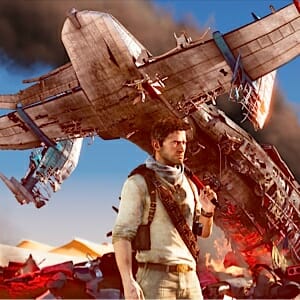
Forget Indiana Jones. Another famous cinematic explorer looms larger over Uncharted 3: Drake’s Deception, and this time it’s someone that actually existed. Naughty Dog’s latest saga drags T. E. Lawrence into its convoluted, globe-hopping plot, adding Lawrence of Arabia to a stable of historical harbingers that include angel-summoning alchemist John Dee and that old stalwart Francis Drake. This time the fabled lost city with surprising mystical properties sought after by explorer Nathan Drake is in the middle of the Rub’al Khali desert, and involves a centuries-old conspiracy known to both Lawrence and Sir Francis. Uncharted continues to muck up the past with the esoteric and supernatural, annoying the history teachers of the world while making conspiracists like me stroke our beards in excitement.
Uncharted 3 owes as much to movies as it does videogames. If it was a movie it wouldn’t be a particularly good one, sidling up alongside The Mummy as an overly loud and bumptious Indiana Jones acolyte whittled down into a formless nub by non-stop spectacle and lowest common denominator handholding. It even has the daddy issues of a Spielberg movie. Thankfully it’s a videogame, where the narrative bar is far lower and the banal quip and perpetual motion of the summer blockbuster remain exciting when done well.

When the banter stops and the characters relate to one another as people Uncharted 3 reveals a human core most games lack. The vivid graphics, fantastic vocal performances, and lifelike character animations make Nathan Drake, Sully, Elena Fisher and the rest feel more like real people than almost any other game characters, even as they regularly perform the unlikely and downright impossible. There remains a disconnect between Drake’s murderous day job and his supposedly charming jocularity, and in Uncharted 3 it’s amplified by the bad guys’ decision to generally wear crisp suits instead of paramilitary gear. We’ve had two games to get used to that contradiction, though, and there’s little point in rehashing the argument. Beyond the bluster Uncharted 3’s most memorable moments are quiet and understated personal interactions devoid of the turgid melodrama of a game like Gears of War 3.
The central relationships are well-defined after three installments, but the villains are barely sketched heavies that exist merely to sneer and (not so) shockingly follow Drake into every uncovered crypt or newly discovered ancient ruin. All we know about the bad guys are that they are British and can afford to send an endless stream of well-dressed men to their bloody deaths. At one point Drake tries to save a particular top villain after killing hundreds of minions, and the dissonance is jarring. Apparently Drake supports the 1% over the 99.
Where did all these men come from? Why do they all look like Jason Statham? How could any organization toss the lives of a thousand men around like confetti, especially a private, secretive, and non-governmentally supported group? It’s best not to think about it, and enjoy this Nathan Fillion wannabe’s bad sit-com wisecracks.

Story is vital to Uncharted games, but they would still stand out even if they were disconnected sequences of action scenes featuring wordless rag dolls. Few developers can match Naughty Dog for epic action set pieces. There are at least three passages in Uncharted 3 that try to channel the sheer chaos of the lengthy shoot-out within a collapsing hotel that was Uncharted 2’s exhilarating highlight. The best of the three, Drake’s escape from a sinking cruise ship, might actually improve upon it.
Like the previous game’s hotel sequence, the cruise ship segment is impressive because of how it exploits our perception of both the game’s rules and our character’s surroundings. As the boat lurches downward, we have to maneuver Drake upwards through hallways and staterooms that tilt sideways, climbing up through doors and over bed frames. Our horizontal axis turns vertical as a wall of water surges towards us and suicidal pirates continue to attack, forcing us to quickly adapt to this new perspective. Eventually we fall into a grand chamber whose skylight is fully submerged. The art deco decor, underwater lighting, and skewed angles recall both Bioshock and The Poseidon Adventure. Sadly there are no cameos from Red Buttons or Shelley Winters.
Moments like that are what make Uncharted 3 great. The game’s cinematic aspirations are impressively realized for a videogame, but its story, characterization, and dialogue wouldn’t be notable in almost any other medium. What would be mindless and regurgitated spectacle in the multiplex is thrilling in a game because we have to react to it, and few games can provoke awed and astonished reactions like Uncharted 3.
Uncharted 3: Drake’s Deception was developed by Naughty Dog and published by Sony Computer Entertainment. It is available for the PlayStation 3.
Paste Games Editor Garrett Martin just moved back to Atlanta after eight years in Boston. He also writes about games for the Boston Herald and the Sarasota Herald-Tribune and has contributed to G4TV.com, Edge Magazine, GamePro, Joystiq, and many others. You can contact him on Twitter at @grmartin or at Garrett [at] Pastemagazine [dot] com.